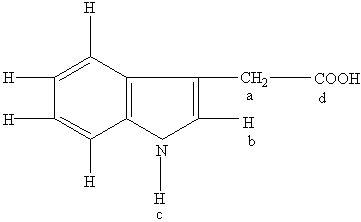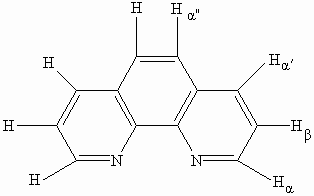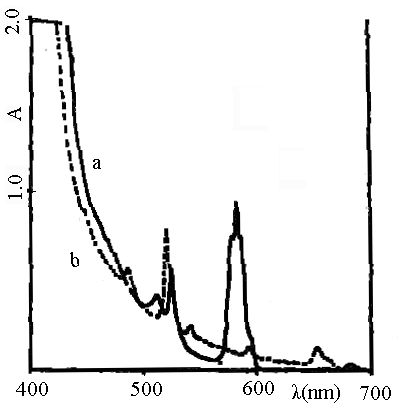| http://www.chemistrymag.org/cji/2006/08a061pe.htm | Oct. 1,
2006 Vol.8 No10 P.61 Copyright |
Zhan
Huiying, Song Zhigang
(College of Chemical Engineering, Gansu Lianhe University, Lanzhou, 730000, China)
Received on Jun 10, 2006.
Abstract Eight new solid complexes of
Indole-3-acetic acid (C8H6N-CH2-COOH, HL) with rare earth
metals (M) and 1,10-phenanthroline (phen) have been synthesized. Elemental analysis, IR,
molar conductance, TG-DTA, 1HNMR spectra have been used to characterize the
complexes. The general formula of the complexes is ML3·phen (M = La, Pr,
Nd, Sm, Eu, Gd, Er, Y). The bioactivity of LaL3·phen complex was tested.
The results obtained showed that the complexes possess increasing effects on the growth of
seedlings.
Keywords Bioactivity, rare earth ternary complex, Indole-3-acetic acid
1. INTRODUCTION
Rare earths are very suitable for a variety of industrial and biological applications,
due mainly to their spectroscopic and magnetic properties. In industry, the applications
of rare earths are many, such as in catalysis, phosphors, magnetic materials, glasses and
lasers. In biological systems, the use of trivalent rare earth ions has attracted a great
deal of interest[1]. In these systems, they are usually used as luminescent
probes in the investigations of binding sites in proteins and other biomolecules, labels
in immunoassays and in non-invasive tests[2]. Auxins represent one of the
important classes of signaling molecules transcribed in plants. They regulate several
fundamental processes including cell division, elongation and differentiation. Exogenously
applied auxins have been reported to stimulate stem elongation in isolated stem segments
as well as in intact plants[3]. Song Z G et al[4] have studied the
coordination of series of plant growth regulators to some transition metals in solution
and the effect of introducing N-containing heterocyclic neutral ligand on the coordination
ability of these regulators. In this paper, the study of rare earth ternary complexes
containing HL and phen is reported.
2. EXPERIMENTAL
2.1 Measurements
Carbon, hydrogen and nitrogen were determined using a Carlo-Erba 1106 elemental analyser
and the rare earth metals by EDTA titration. The IR spectra were recorded on a
Nicolet-170SX FT-IR spectrophotometer using KBr tablets in the range of 4000-200cm-1.
1HNMR spectra were obtained using a Varian FT-80A spectrometer with d6-acetone
as the solvent and TMS as the internal reference. Thermal analyses were performed using a
Beijing Analytical Instrument Plant PCT-2 thermal balance. Absorbencies were determined on
a Shimadzu UV-240 spectrophotometer at 560nm.
2.2 Reagents
The chemicals used were analytical grade. The hydrated lanthanide (
2.3 Synthesis of the sodium salt of ligand (NaL)
HL was dissolved with equimolar sodium hydroxide (NaOH) methanol solution. The mixture was stirred until clear, then the solution was put on a water bath to evaporate until a crystal film appeared. The product obtained was collected by filtration and dried over molecular sieves under vacuum. The purity of the product was also confirmed by elemental analysis and IR spectra.
2.4 Synthesis of the complexes
3mmol HL and 3mmol NaOH were dissolved in 10cm3 methanol. Under stirring, a solution of MCl3·nH2O (1mmol) and 1.5mmol phen·H2O methanol (10cm3) was added to the mixture and the precipitate appeared immediately. After stirring the mixture at room temperature for 3h, the precipitate was collected by filtration, washed with methanol three times, and dried in a vacuum dissociactor to constant weight. Eight rare earth (III) complexes with HL and phen were prepared by the same method respectively.
2.5 Test for bioactivity of the complex
Uniform grown seedling of Gansu 1116 wheat was used for the test. Five samples averaged for each concentration and different lots of seedling were used for ligand HL and complexes. The seedlings were illuminated (2000-3000lux) at 20-30oC for 5 days.
3. RESULTS AND DISCUSSIONS
3.1 Composition and properties of the complexes
Elemental composition, molar conductance and molecular formula of the complexes are listed
in Table 1. The complexes are stable in air and soluble in DMF, DMSO methanol and ethanol,
while insoluble in water. As seen in Table 1, the molar conductances of complexes in DMSO
at 25
Table 1 Elemental composition and molar conductance of the ternary complexes
Compound |
color |
m.p ( oC) |
experimental values (%) |
Molar conductance /s·cm2·mol-1 (DMSO) |
|||
RE |
C |
H |
N |
||||
La(IAA)3·phen |
pale yellow |
251-254 |
16.23(16.50) |
59.82(59.88) |
3.78(3.80) |
8.25(8.32) |
16.98 |
Pr(IAA)3·phen |
pale yellow |
240-243 |
16.49(16.70) |
58.29(59.79) |
3.69(3.79) |
7.96(8.30) |
16.41 |
Nd(IAA)3·phen |
pale yellow |
245-247 |
17.10(17.02) |
58.62(59.50) |
3.78(3.78) |
8.28(8.26) |
18.06 |
Sm(IAA)3·phen |
pale yellow |
235-237 |
17.55(17.63) |
58.66(59.07) |
3.66(3.75) |
8.18(8.20) |
14.82 |
Eu(IAA)3·phen |
pale yellow |
234-236 |
17.92(17.78) |
58.59(58.97) |
3.69(3.74) |
8.10(8.19) |
18.52 |
Gd(IAA)3·phen |
pale yellow |
253-255 |
18.85(18.53) |
58.29(58.50) |
3.67(3.72) |
8.17(8.14) |
16.66 |
Er(IAA)3·phen |
pale red |
230-232 |
19.36(19.23) |
57.67(57.93) |
3.50(3.68) |
7.98(8.05) |
15.64 |
Y(IAA)3·phen |
pale yellow | 246-248 |
11.07(11.23) |
63.64(63.66) |
4.00(4.04) |
8.87(8.84) |
18.22 |
3.2 IR spectrum
The important IR data of ligand and its typical complexes are listed in Table 2. The
absorption peaks at 1517 and 840cm-1 of the complexes can be attributed to ring
vibration of phen, the original ring vibration of phen at 1558cm-1 and C-H
vibration at 852 cm-1 are red shifted[6]. Theses facts indicate the
participation of phen in coordination.
Table 2 Characteristic IR frequendies(cm-1) of ligand and the complexes
compound |
|
|
|
|
|
|
|
|
|
phen·H2O |
1558 |
852 |
|||||||
IAA |
3389 |
1334 |
|||||||
Na(IAA) |
3390 |
1565 |
1416 |
149 |
1344 |
||||
La(IAA)3·phen |
3408 |
1590 |
1424 |
166 |
1517 |
1345 |
841 |
535 |
267 |
Gd(IAA)3·phen |
3408 |
1604 |
1426 |
178 |
1517 |
1347 |
840 |
537 |
279 |
Y(IAA)3·phen |
3408 |
1609 |
1426 |
183 |
1517 |
1345 |
840 |
536 |
281 |
The absence of water molecules in the formula
is confirmed by the absence OH vibration in the spectra. The N-atom of HL does not take
part in coordination (little change of ![]() ).
There are two sets of
).
There are two sets of ![]() and
and ![]() in the complexes indicating existence of
two coordination modes between the coo- of HL and the rare earth metal ion[3].
In order to meet the requirement of change number, there are three HL molecules taking
part in coordination. Probably two HL molecules are in monodentate mode (
in the complexes indicating existence of
two coordination modes between the coo- of HL and the rare earth metal ion[3].
In order to meet the requirement of change number, there are three HL molecules taking
part in coordination. Probably two HL molecules are in monodentate mode (![]() around 166-183cm-1, greater than
149cm-1 of NaL) and one HL molecule in bidentate mode (84-100cm-1,
smaller than 149cm-1 of NaL), that is the complexes are 6-coordinate[7].
around 166-183cm-1, greater than
149cm-1 of NaL) and one HL molecule in bidentate mode (84-100cm-1,
smaller than 149cm-1 of NaL), that is the complexes are 6-coordinate[7].
Further supports for the existence of the M-O bond and the M-N bond are
the presence of a new bond at about 536 cm-1 and 526 cm-1, 267-281
cm-1 due to ![]() .
.
3.3 1HNMR spectrum
LaL3·phen and YL3·phen were used for this study. The
number of proton and the relational data are shown in Figure 2 and Table 3 separately. The
spectra show the participation of phen (7.86-9.40ppm) and deprotonated HL (disappearance
of the HL proton peak at 12.22ppm) in coordination. The nitrogen atom on the HL indole
ring does not appear to participate in coordination since there is no apparent change of
imino proton shift at 11.00ppm[7].


Figure 1 The labelled proton of ligand and the complexes
Table 3 1HNMR data of ligands and La(m) complex (d/ppm)
Compound |
a |
b |
c |
d |
a |
b |
a' |
a '' |
phen·H2O |
9.09 |
8.01 |
8.46 |
7.74 |
||||
IAA |
2.53 |
6.90-7.73 |
11.03 |
12.22 |
||||
La(IAA)3·phen |
2.53 |
6.76-7.73 |
10.83 |
9.40 |
8.10 |
8.62 |
7.86 |
3.4 Thermal analysis
From Table 4, we realize that the thermal behavior of eight complexes are alike indicating
their similarity in coordination structure. They do not contain water molecules since are
there no heat absorption peak around 100
Table 4 The thermal data of RE(IAA)3·phen
Complex |
Crystalline transformation temperature ( oC) |
Decomposition temperature ( oC) |
Residue at 800 oC |
Residue weight percentage |
|
Theory |
Experiment |
||||
La(IAA)3·phen |
251 |
300 |
La2O3 |
19.36 |
20.00 |
Gd(IAA)3·phen |
253 |
282 |
Gd2O3 |
21.08 |
21.21 |
Er(IAA)3·phen |
230 |
293 |
Er2O3 |
21.99 |
23.30 |
3.5 Electronic spectrum
The f→f transition absorption spectra and
designation of Nd(m) and Er(m) complexes are shown in Figure 3 and Table 5. The covalent
parameters (

Figure 2 The electron spetra l(nm) of Nd(IAA)3·phen(a) and Er(IAA)3·phen(b)
Table 5 The f→f transition absorption peaks of complexes(cm-1)
Complex |
nc |
na |
Designation |
Reference value |
Nd(IAA)3·phen |
17271 |
17397 |
4 I9/2→4G5/2、2G7/2 |
|
19048 |
19182 |
→4G7/2 |
d= 0.79 | |
19455 |
19512 |
→4G9/2 |
b1/2= 0.088 |
|
21008 |
21039 |
→4G11/2 |
||
21277 |
21720 |
→1P1/2 |
||
Er(IAA)3·phen |
18416 |
18470 |
4 I15/2→4S3/2 |
|
19194 |
19149 |
→2H11/2 |
δ= 0.07 |
|
20534 |
20559 |
→4F7/2 |
b1/2= 0.019 |
|
22222 |
22241 |
→4F5/2 |
3.5 Effect on growth
As seen from Table 6, the ligand HL promoted the elongation of first leaf (L1)
within the concentration range tested, The effect was increased with the increasing
concentration of compound, but the lanthanum complex possesses inhibition slightly. HL
inhibited the certain elongation of the second leaf (L2) but the complex
promoted the elongation. As for the length of the root (L), there was an optimum complex
concentration (1.00ppm) for the promotion while the ligand inhibited the elongation over
the whole concentration range tested. The root number (N) was increased by HL ligand and
the complex. As a whole, the ternary complex tested seems to give better effect on the
growth of wheat seedling.
Table 6 Effect of HL and LaL3·phen on the growth of wheat seedlings
10-6HL concentration |
0.0 |
0.5 |
1.0 |
2.0 |
4.0 |
8.0 |
16.0 |
32.0 |
64.0 |
L1/mm |
90.5 |
100.0 |
92.0 |
97.0 |
92.0 |
92.0 |
95.0 |
93.0 |
93.0 |
L2/mm |
149.5 |
148.0 |
141.0 |
149.0 |
145.0 |
131.0 |
141.0 |
137.0 |
120.0 |
L/mm |
112.5 |
117.0 |
108.0 |
110.0 |
109.0 |
107.0 |
110.0 |
97.0 |
95.0 |
N |
6.2 |
6.2 |
6.9 |
6.6 |
6.2 |
6.5 |
6.9 |
7.4 |
7.6 |
10-6LaL3·phen concentration |
0.00 |
0.02 |
0.05 |
0.10 |
0.50 |
1.00 |
2.00 |
5.00 |
10.00 |
L1/mm |
103.5 |
97.0 |
108.3 |
102.5 |
101.5 |
102.0 |
98.8 |
97.6 |
96.6 |
L2/mm |
135.9 |
138.6 |
137.3 |
138.4 |
139.6 |
140.7 |
142.9 |
144.4 |
145.2 |
L/mm |
166.0 |
179.0 |
164.0 |
170.1 |
177.4 |
209.9 |
169.4 |
168.2 |
150.9 |
N |
6.2 |
6.1 |
6.2 |
6.2 |
6.6 |
6.7 |
7.2 |
7.6 |
8.2 |
REFERENCES
[1] Ivanov R A, Korsakov I E, Formanovskii A A et al. Russian Journal of Coordination
Chemistry, 2002, 28(9): 713.
[2] Keskinov V A, Lishchuk V V, Pyartman A K et al. Russian Journal of Applied Chemistry,
2006, 79(3): 360.
[3] Statvir K. Anil K G, Narinder K. Plant Growth Regulation, 2003, 39: 91.
[4] Song Z G. Application Chemistry, 1999, 16(1):21.
[5] Gao E J, Liu Q T. Acta Chimica Sinica, 2005, 63(8):725.
[6] Yang J X, Hu Z J. Chinese Journal of Chemistry, 2005, 23(5): 533.
[7] Pang X A, Yao Y M. Chinese Journal of Chemistry, 2005, 23(9): 1193.
[8] Khatia I H. Bull. Chem. Soc. Jpn., 1982, 55(7):2258.
[9] GAN X, XIE Y. Acta Chimica Sinica, 2005, 63(14):1307.
展惠英 宋之刚
(甘肃联合大学 化工学院 甘肃 兰州 730000)
摘要 合成了八种RE(IAA)3·phen三元配合物(RE:La、Pr、Nd、Sm、Eu、Gd、Er、Y;IAA:吲哚-3-乙酸;phen: 邻菲啰啉).通过元素分析、红外光谱、电子吸收光谱、1HNMR谱、热重-差热分析等方法对标题化合物的结构和性质进行了研究,并探讨了La(IAA)3·phen对小麦幼苗的影响。
关键词 稀土三元配合物;吲哚-3-乙酸;合成;生物活性